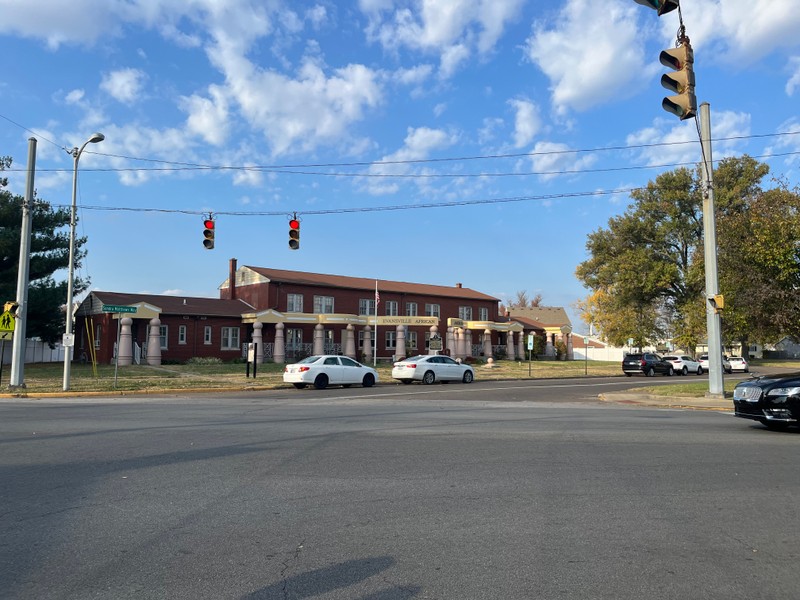Lincoln Gardens
Introduction
Text-to-speech Audio
Lincoln Gardens was created as a way to give affordable housing to the members of Baptisttown at the end of the Great Depression.[1] It allowed African Americans in Evansville a place to live without worrying about the cost of rent and utilities. The original houses of the area were run down and did not even have running water, so the old houses were torn down and new ones were built. Today, only one building remains, and it is now the Evansville African American Museum. This museum is dedicated to spreading information regarding Lincoln Gardens and African American history as a whole.
[1] Hunt, Tamara L. and Weight, Donovan. "Rediscovering 'Baptistown'": A Historical Geography Project on Local African American History," pp. 1.
Images
Evansville African American Museum, formerly Lincoln Gardens

Backstory and Context
Text-to-speech Audio
Before the creation of Lincoln Gardens, Baptisttown was “dominated by filthy shacks without sanitation facilities.”[1] A majority of these shacks were rented, rather than owned. In fact, by 1900, only 9% of black households owned their home. [2] The rental homes in Baptisttown were not connected to plumbing, so most of the water supply was from cisterns. A vast majority of the homes dilapidated and falling apart. Not only were the houses in disarray, but overpopulation was a major issue. From 1870 to 1890, the population of Baptisttown increased by 350%. [3] With the combination of unstable housing and overpopulation, Baptisttown was in need of change.
The idea of renovating Baptisttown had been around for quite a while, although nothing had truly been done to help. That was until Lincoln High School principal William Best met with Evansville’s mayor, Frank Griese. Although it is unclear what this conversation entailed exactly, six weeks later, it was announced that housing conditions in the city would be surveyed. [4] By the end of January 1936, demolition of the future location of Lincoln Gardens began. Creating a plan for the future houses wasn’t easy, though. Some thought it simply would not be possible to build housing that would be cheap enough. To ease this problem, the houses were increased to two stories and central heating was eliminated in favor of individual furnaces. The rent would still be too expensive, however. After fully revising the plans, family units were increased to 191, individual heating systems were put in each building, and landscaping costs were cut. Interest was also reduced to 1%, which lowered to rent to around $4.50 per room per month. The rent was finally cheap enough. After years and years of discussion and planning, construction of Lincoln Gardens began in mid-June of 1936. [5]
The new houses of Baptisttown were a success. By August, there were 408 applications received and 114 families had moved in. On November 23, 100% of the housing had been filled.[6] Monthly gross rents were anywhere from $12.65 to $20.20 initially, based on where the unit was located and how big it was. In order to qualify for housing in Lincoln Gardens, one could not make more than five times the monthly rent, and applicant must show good character. Lincoln Gardens had a social room for tenants to use, and also recreation rooms that could be used as classrooms. By 1940, Lincoln Gardens was a growing mini-community that was full of life. [7]
Unfortunately, this did not last for long. By the 1990s, Lincoln Gardens had a 40% vacancy rate and many of the housing units were outdated. In 1997, there were plans to demolish the buildings, however one was left standing. Editor and publisher of Our Times newspaper spoke with the Evansville Housing Board of Commissioners and asked that part of Lincoln Gardens be preserved as a way to educate the public on the history of Baptisttown. [8]The Commissioners agreed, and the Evansville African American Museum was created. The mission of this museum is to “continually develop a resource and cultural center to collect, preserve, and educate the public on the history and traditions of African American families, organizations and communities.”[9] Today, anyone can go on a tour of the museum for only $7.
[1] “New Deal Public Housing in the Ohio Valley: The Creation of Lincoln Gardens in Evansville, Indiana” in Ohio Valley History, vol. 14, no. 1, 2014, pp. 55.
[2] Ibid., pp. 54
[3] Ibid., pp. 55
[4] Ibid., pp. 55
[5] Ibid., pp. 62-63
[6] Ibid., pp. 67
[7] Ibid., pp. 65
[8] Ibid., pp. 68
[9] "About Us" Evansville African American Museum, https://evvaam.org/content.aspx?page_id=22&club_id=69634&module_id=516617.
Sources
"About Us" Evansville African American Museum, https://evvaam.org/content.aspx?page_id=22&club_id=69634&module_id=516617.
Hunt, Tamara L. and Weight, Donovan. "Rediscovering 'Baptistown'": A Historical Geography Project on Local African American History."
“New Deal Public Housing in the Ohio Valley: The Creation of Lincoln Gardens in Evansville, Indiana” in Ohio Valley History, vol. 14, no. 1, 2014, pp. 51-72.
"New Lincoln Gardens, Pride of City; Now 100 Percent Occupied." Evansville Argus (Evansville, IN) Dec. 3, 1938.
Taken by Gloria Hinterscher
